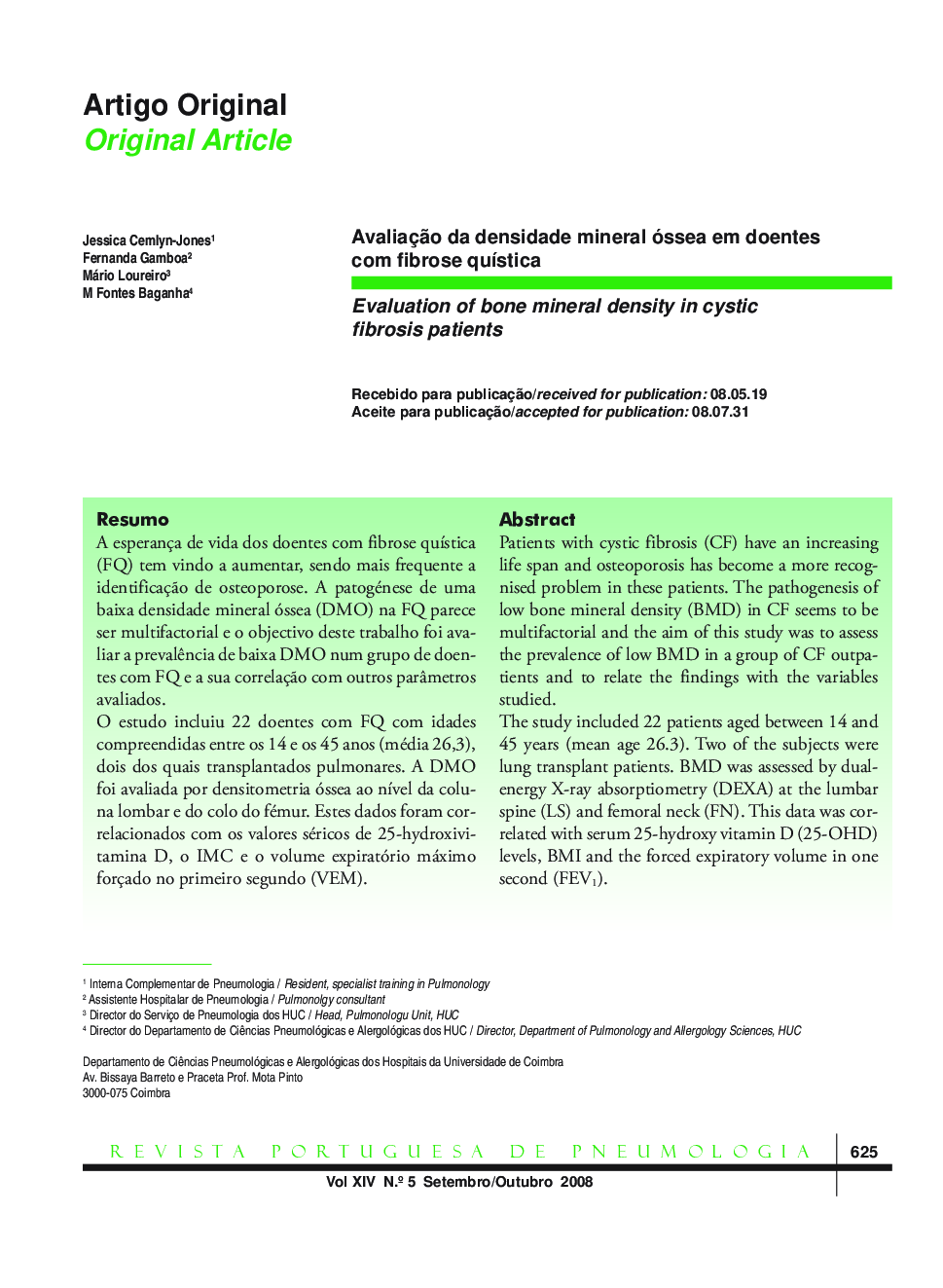| Article ID | Journal | Published Year | Pages | File Type |
|---|---|---|---|---|
| 4215200 | Revista Portuguesa de Pneumologia (English Edition) | 2008 | 10 Pages |
Patients with cystic fibrosis (CF) have an increasing life span and osteoporosis has become a more recognised problem in these patients. The pathogenesis of low bone mineral density (BMD) in CF seems to be multifactorial and the aim of this study was to assess the prevalence of low BMD in a group of CF outpatients and to relate the findings with the variables studied.The study included 22 patients aged between 14 and 45 years (mean age 26.3). Two of the subjects were lung transplant patients. BMD was assessed by dualenergy X-ray absorptiometry (DEXA) at the lumbar spine (LS) and femoral neck (FN). This data was correlated with serum 25-hydroxy vitamin D (25-OHD) levels, BMI and the forced expiratory volume in one second (FEV1).BMD (Z-score and T-score) ranged from 0.6 to -6 and from 0.5 to -6.7 at LS; at FN the scores ranged from 0.6 to -3.9 and from 0.6 to -4.1. The mean serum 25-OHD concentration (12,57 ng/ml) was at the low end of the normal range (10-60 ng/ml). On average patients did not present with malnutrition, however BMI ranged from 15.2 to 33.7 kg/m2. Lung function status was assessed by FEV1; 64% of patients had FEV1 below 80% and within this group four patients had a FEV1 under 40%.There was a positive correlation between low BMD and 25-OHD concentrations and also between BMD and FEV1. There was no linear correlation between BMD and BMI.
ResumoA esperança de vida dos doentes com fibrose quística (FQ) tem vindo a aumentar, sendo mais frequente a identificação de osteoporose. A patogénese de uma baixa densidade mineral óssea (DMO) na FQ parece ser multifactorial e o objectivo deste trabalho foi avaliar a prevalência de baixa DMO num grupo de doentes com FQ e a sua correlação com outros parâmetros avaliados.O estudo incluiu 22 doentes com FQ com idades compreendidas entre os 14 e os 45 anos (média 26,3), dois dos quais transplantados pulmonares. A DMO foi avaliada por densitometria óssea ao nível da coluna lombar e do colo do fémur. Estes dados foram correlacionados com os valores séricos de 25-hydroxivitamina D, o IMC e o volume expiratório máximo forçado no primeiro segundo (VEM).Os valores da DMO (Z-score e T-score) variaram entre 0,6 e -6 e entre 0,5 e -6,7, respectivamente, a nível da coluna lombar e entre 0,6 e -3,9 e 0,6 e -4,1 a nível do colo do fémur. A média das concentrações séricas de 25-(OH)D (12,57 ng/ml) encontrava-se no limite inferior da normalidade (10-60 ng/ml). Em média os doentes não apresentavam malnutrição mas os valores de IMC variam entre 15,2 e 33,7 kg/m2. Relativamente à função pulmonar, 64% dos doentes apresentavam VEM inferior a 80% e, destes, quatro tinham valores inferiores a 40%. Foi encontrada uma correlação positiva entre valores baixos de DMO e VEM, assim como entre valores de DMO e 25-OHD. Não houve correlação linear entre IMC e DMO.
